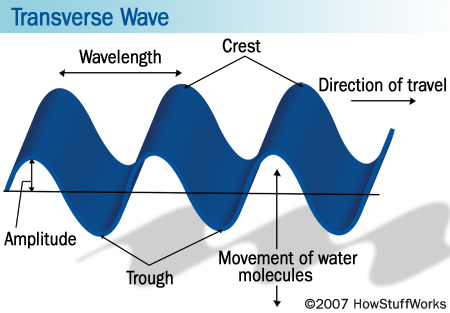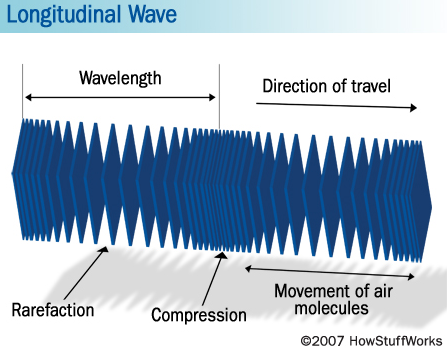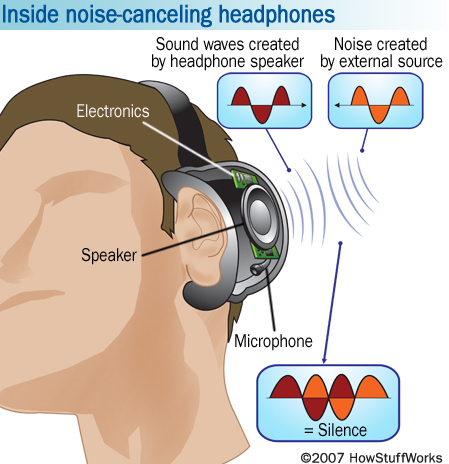Ambient noise is the enemy of all music lovers; fortunately, noise-canceling headphones save us from the maddening hum of white noise. Make no mistake, the distinction between white noise and music is not subjective. Music consists of a series of reproducible distinct waveforms while white noise consists of varying frequencies that are random and unpredictable.
Sound wave characteristics
In order to understand how noise canceling headphones work, it’s imperative to first understand the basics of how sound waves function. In short, sound waves, which are longitudinal waves, have similar characteristics to the transverse waves such as those seen in shallow water. Transverse waves cause a disturbance in a medium perpendicular to the direction of the advancing wave. The crests and troughs in the wave reflect the wave’s amplitude, while the distance between two crests/troughs is indicative of the wavelength. Finally, the number of crests passing through a fixed point per second is known as the frequency of the wave.

Alternatively, longitudinal waves are the disturbance in a medium moving parallel to the direction of the wave; they are produced from the mechanical vibrations that originate from a series of compressions and rarefactions in that medium. For example, strumming a guitar string causes the vibrating air to push against the standing still air molecules, resulting in a section of molecules pressing together while another is spreading apart. The compression parallels a transverse wave’s crest while the rarefaction corresponds to the trough; therefore, the distance between two compressions measures the wavelength.

Passive noise-canceling headphones
Noise canceling headphones exist in two varieties: active or passive. Passive noise reduction initiates from the type of material used to construct the headphones, and excels at dampening higher frequency sounds. Regardless, the majority of noise-canceling headphones provide passive reduction, as most are constructed with layers of sound-absorbing materials such as high-density foam. With that said, the most efficient passive noise-canceling headphones are circum-aural, or closed-back headphones that cup around the ear to form an airtight seal. Average noise reduction is about 15 to 20 decibels, significantly less than the 75 to 80 dB produced by a jet engine.
Active noise-canceling headphones
Active noise-canceling headphones are one step above the passive sort; they actively erase lower-frequency sound waves by creating their own sound waves to replicate the exact traits of incoming sound in all but one way, they are 180 degree reflections of intruding waves. This phenomenon, known as destructive interference, actually cancels out incoming white noise and reduces sound by another 20 dB.

Destructive interference is accomplished by producing a wave with the same frequency and amplitude as the incoming wave, and arranging its crests and troughs, or compressions and rarefactions if you will, to mirror those of the incoming wave. This effectively cancels the white noise.
How do they work?
The dynamic engagement of active noise-canceling headphones is carried out by the culminated efforts of three active components: a microphone, noise-canceling circuitry, and a speaker.
The microphone is placed inside the ear cup to detect whatever white noise makes its way past the passive canceling components. Special circuitry then senses the microphone’s input and generates a matching pattern of the noise from it. This pattern serves as a template for creating a new 180 degree reflection. The ensuing “reverse-wave,” or “anti-wave,” is fed through the headphone’s speaker simultaneous to the normal sound. The process of destructive interference is then initiated and the white noise is destroyed, leaving only the desired sound waves. Also worth mentioning is the fact that active-noise canceling headphones must rely on a rechargeable battery of some sort to power the ongoing operation.
Noise reduction makes you rested
Traveling fatigue is often enhanced by constant exposure to low-frequency noises over an extended period of time; switching to noise-canceling headphones can not only enhance your listening experience in noisy environments such as offices, subway trains, or airplanes, but also provide a silence devoid of noise altogether. The only trade-off to these headphones is that possibility of compromising overall sound quality, as some users have reported. Others have claimed that they’ve experienced air pressure build-up in the headphones cups. Of course with proper research and a bit of extra funding, one can invest in a higher quality pair of headphones that actually alleviates these issues. Regardless, most modern active-noise canceling headphones vent air trapped behind the speaker using special ports, this way there’s no pressure build up.
Do you have your own DIY noise-canceling solution? Visit TechXchange to share and critique.
Advertisement
Learn more about Digi-Key





